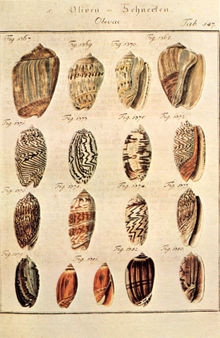
Johann Hieronymus Chemnitz
Encyclopedia

Germany
Germany , officially the Federal Republic of Germany , is a federal parliamentary republic in Europe. The country consists of 16 states while the capital and largest city is Berlin. Germany covers an area of 357,021 km2 and has a largely temperate seasonal climate...
clergyman and a conchologist
Conchology
Conchology is the scientific or amateur study of mollusc shells. Conchology is one aspect of malacology, the study of molluscs, however malacology studies molluscs as whole organisms, not just their shells. Conchology pre-dated malacology as a field of study. It includes the study of land and...
.
He continued the work of Friedrich Wilhelm Martini
Friedrich Wilhelm Martini
Friedrich Wilhelm Martini was a German physician and conchologist.Martini who practised in Hamburg began, in 1769 , the richly colour illustrated shell book: Neues systematisches Conchylien-Cabinet. But he died after the publication of the third volume. His work was continued by Johann Hieronymus...
(1729–1778), Neues systematisches Conchylien-Cabinet. He added to the three volumes previously published eight new volumes in 1779 and 1795.
Although neither of the two authors use the binomial system, they are regarded as the authors of many species
Species
In biology, a species is one of the basic units of biological classification and a taxonomic rank. A species is often defined as a group of organisms capable of interbreeding and producing fertile offspring. While in many cases this definition is adequate, more precise or differing measures are...
which were first described in this work. Chemnitz used many specimens from cabinet of curiosities
Cabinet of curiosities
A cabinet of curiosities was an encyclopedic collection in Renaissance Europe of types of objects whose categorical boundaries were yet to be defined. They were also known by various names such as Cabinet of Wonder, and in German Kunstkammer or Wunderkammer...
of the king of Denmark whose conservator was Lorenz Spengler
Lorenz Spengler
Lorenz Spengler was a Swiss-born Danish turner and naturalist.He arrived at Copenhagen in 1743. He was a tutor to Christian VI of Denmark and later Frederick V of Denmark in the art of turning. From 1771 he was head of the Royal Art Chamber , a position he held until his death in...
(1720–1807). Chemnitz began with a collection of half shells before collecting whole shells. His patron was Christian Hee Hwass
Christian Hee Hwass
Christian Hee Hwass was a Danish malacologist who is remembered for his work in conchology. Although born in Denmark, Hwass did most of his important work in France. He moved to Paris in 1780, and later Auteuil...
(1731–1803).

